Assessing the Environmental Potential of Collaborative Consumption: Peer-to-Peer Product Sharing in Hammarby Sjöstad, Sweden
Abstract
1. Introduction
2. Methodology
2.2. Methodology for Reviewing Environmental Impacts of Sharing Services
2.1. Sharing Services in Hammarby Sjöstad, Stockholm
2.3. Scenarios
2.3.1. Baseline Scenario
2.3.2. Sharing Scenario
Product Use and Lifetime
Platform and Infrastructure for Sharing
Replaced Products
2.3.3. Integrated Scenario for Improved Logistics through the Sharing Locker Service
3. Results and Analysis
3.1. Online Sharing Platform
Sensitivity to Data and Methodological Choices
Replaced Products
Product Lifetime
Distance/Transportation
Use of the Products
3.2. Integration with Locker Services
4. Discussion
4.1. Products and Avoided Purchases
4.2. Product Use and Lifetime
4.3. Transportation and Integrating Services
4.4. Impacts of Online Services
4.5. Sustainability and Rebound Effects
4.6. System Boundaries and Data
5. Conclusions
6. Future Research Suggestions
Supplementary Materials
Author Contributions
Funding
Acknowledgements
Conflicts of Interest
References
- Acquier, A.; Daudigeos, T.; Pinkse, J. Promises and paradoxes of the sharing economy: An organizing framework. Technol. Forecast. Soc. Chang. 2017, 125, 1–10. [Google Scholar] [CrossRef]
- Gruszka, K. Framing the collaborative economy—Voices of contestation. Environ. Innov. Soc. Transit. 2016. [Google Scholar] [CrossRef]
- Botsman, R.; Rogers, R. What’s Mine is Yours: How Collaborative Consumption is Changing the Way We Live; Collins: London, UK, 2011. [Google Scholar]
- Rifkin, J. The Zero Marginal Cost Society: The Internet of Things, the Collaborative Commons, and the Eclipse of Capitalism; Palgrave Macmillan: London, UK, 2014. [Google Scholar]
- Martin, C.J. The sharing economy: A pathway to sustainability or a nightmarish form of neoliberal capitalism? Ecol. Econ. 2016, 121, 149–159. [Google Scholar] [CrossRef]
- Heinrichs, H. Sharing economy: A potential new pathway to sustainability. GAIA Ecol. Perspect. Sci. Soc. 2013, 22, 228–231. [Google Scholar] [CrossRef]
- Hoekstra, A.Y.; Wiedmann, T.O. Humanity’s unsustainable environmental footprint. Science 2014, 344, 1114–1117. [Google Scholar] [CrossRef]
- Böcker, L.; Meelen, T. Sharing for people, planet or profit? Analysing motivationsfor intended sharing economy participation. Environ. Innov. Soc. Transit. 2017, 23, 28–39. [Google Scholar] [CrossRef]
- Boons, F.; Bocken, N. Towards a sharing economy—Innovating ecologies of business models. Technol. Forecast. Soc. Chang. 2018. [Google Scholar] [CrossRef]
- Sprei, F.; Ginnebaugh, D. Unbundling cars to daily use and infrequent use vehicles—the potential role of car sharing. Energy Effic. 2018, 11, 1433–1447. [Google Scholar] [CrossRef]
- Jung, J.; Koo, Y. Analyzing the Effects of Car Sharing Services on the Reduction of Greenhouse Gas (GHG) Emissions. Sustainability 2018, 10, 539. [Google Scholar] [CrossRef]
- Zamani, B.; Sandin, G.; Peters, G.M. Life cycle assessment of clothing libraries: Can collaborative consumption reduce the environmental impact of fast fashion? J. Clean. Prod. 2017, 162, 1368–1375. [Google Scholar] [CrossRef]
- Iran, S.; Schrader, U. Collaborative fashion consumption and its environmental effects. J. Fash. Market. Manag. 2017, 21, 468–482. [Google Scholar] [CrossRef]
- Dornier, R.; Selmi, N. Peer-to-peer accommodation and sustainability in mountain areas. Worldwide Hospital. Tour. Themes 2018, 10, 259–266. [Google Scholar] [CrossRef]
- Tussyadiah, I.P.; Pesonen, J. Impacts of Peer-to-Peer Accommodation Use on Travel Patterns. J. Travel Res. 2016, 55, 1022–1040. [Google Scholar] [CrossRef]
- Ala-Mantila, S.; Ottelin, J.; Heinonen, J.; Junnila, S. To each their own? The greenhouse gas impacts of intra-household sharing in different urban zones. J. Clean. Prod. 2016, 135, 356–367. [Google Scholar] [CrossRef]
- Underwood, A.; Fremstad, A. Does sharing backfire? A decomposition of household and urban economies in CO2 emissions. Energy Policy 2018, 123, 404–413. [Google Scholar] [CrossRef]
- Leismann, K.; Schmitt, M.; Rohn, H.; Baedeker, C. Collaborative Consumption: Towards a Resource-Saving Consumption Culture. Resources 2013, 2, 184. [Google Scholar] [CrossRef]
- Mont, O. Reducing life-cycle environmental impacts through systems of joint use. Green. Manag. Int. 2004, 45, 63–77. [Google Scholar] [CrossRef]
- Clewlow, R.R.; Mishra, G.S. Disruptive Transportation: The Adoption, Utilization, and Impacts of Ride-Hailing in the United States; Institute of Transportation Studies, University of California: Davis, CA, USA, 2017. [Google Scholar]
- Briceno, T.; Peters, G.; Solli, C.; Hertwich, E. Using Life Cycle Approaches to Evaluate Sustainable Consumption Programs: Car-Sharing; Working Papers from Industrial Ecology Programmme (IndEcol); NTNU: Trondheim, Norway, 2005; pp. 1504–3681. [Google Scholar]
- Agrawal, V.V.; Ferguson, M.; Toktay, L.B.; Thomas, V.M. Is leasing greener than selling? Manag. Sci. 2012, 58, 523–533. [Google Scholar] [CrossRef]
- Parguel, B.; Lunardo, R.; Benoit-Moreau, F. Sustainability of the sharing economy in question: When second-hand peer-to-peer platforms stimulate indulgent consumption. Technol. Forecast. Soc. Chang. 2017, 125, 48–57. [Google Scholar] [CrossRef]
- Cohen, B.; Muñoz, P. Sharing cities and sustainable consumption and production: Towards an integrated framework. J. Clean. Prod. 2016, 134, 87–97. [Google Scholar] [CrossRef]
- Finnveden, G.; Hauschild, M.Z.; Ekvall, T.; Guinée, J.; Heijungs, R.; Hellweg, S.; Koehler, A.; Pennington, D.; Suh, S. Recent developments in Life Cycle Assessment. J. Environ. Manag. 2009, 91, 1–21. [Google Scholar] [CrossRef] [PubMed]
- Ecoinvent. The Ecoinvent Database v 3.3. Zurich, Switzerland, 2016. Available online: https://www.ecoinvent.org/database/ecoinvent-33/ecoinvent-33.html (accessed on 28 January 2017).
- Blocket. Begagnathandelns Klimatnytta. 2013. Available online: http://www.ivl.se/download/18.422aa27a15260b0160f1a4/1453820203582/Beg.handel_klimatnytta_rapport.pdf (accessed on 5 November 2018).
- Pandis Iverroth, S. Industrial Ecology for Sustainable Urban Development—The Case of Hammarby Sjöstad. Ph.D. Thesis, KTH-Royal Institute of Technology, Stockholm, Sweden, 2014. [Google Scholar]
- Hygglo. Personal Communication with Hygglo.se about Data for Sharing, Products, etc. January 2018. Available online: www.hygglo.se (accessed on 5 November 2018).
- Malmodin, J.; Lundén, D.; Moberg, Å.; Andersson, G.; Nilsson, M. Life Cycle Assessment of ICT. J. Ind. Ecol. 2014, 18, 829–845. [Google Scholar] [CrossRef]
- Malmodin, J.; Lundén, D. The Energy and Carbon Footprint of the ICT and E&M Sector in Sweden 1990-2015 and Beyond; Advances in Computer Science Research; ICT for Sustainability: Amsterdam, The Netherlands, 2016. [Google Scholar]
- Costenaro, D.; Duer, A. The Megawatts behind Your Megabytes: Going from Data-Center to Desktop. ACEEE Summer Study on Energy Efficiency in Buildings. Available online: https://aceee.org/files/proceedings/2012/data/papers/0193-000409.pdf (accessed on 24 December 2018).
- Google. Powering a Google Search. 2009. Available online: https://googleblog.blogspot.se/2009/01/powering-google-search.html (accessed on 5 November 2018).
- Google. Google Official Blog. Gmail, It’s Cooler in the Cloud. 2014. Available online: https://googleblog.blogspot.se/2011/09/gmail-its-cooler-in-cloud.html (accessed on 5 November 2018).
- Apple. IPhone 7 Environmental Report. 2016. Available online: https://images.apple.com/environment/pdf/products/iphone/iPhone_7_PER_sept2016.pdf (accessed on 5 November 2018).
- Woolridge, A.C.; Ward, G.D.; Phillips, P.S.; Collins, M.; Gandy, S. Life cycle assessment for reuse/recycling of donated waste textiles compared to use of virgin material: An UK energy saving perspective. Resour. Conserv. Recycl. 2006, 46, 94–103. [Google Scholar] [CrossRef]
- Martin, E.; Shaheen, S. Greenhouse Gas Impacts of Car Sharing in North America. IEEE Trans. Intell. Transp. Syst. 2011, 12, 1074–1086. [Google Scholar] [CrossRef]
- Martin, M.; Svensson, N.; Eklund, M. Who gets the benefits? An Approach to Assess the Environmental Performance of Industrial Symbiosis. J. Clean. Prod. 2013, 98, 263–271. [Google Scholar] [CrossRef]
- Ekvall, T.; Weidema, B. System boundaries and input data in consequential life cycle inventory analysis. Int. J. Life Cycle Assess. 2004, 9, 161–171. [Google Scholar] [CrossRef]
- Kjaer, L.L.; Pagoropoulos, A.; Schmidt, J.H.; McAloone, T.C. Challenges when evaluating Product/Service-Systems through Life Cycle Assessment. J. Clean. Prod. 2016, 120, 95–104. [Google Scholar] [CrossRef]
- Brandao, M.; Martin, M.; Cowie, A.; Hamelin, L.; Zamagni, A. Consequential Life Cycle Assessment: What, How, and Why? Reference Module in Earth Systems and Environmental Sciences; Elsevier: Amsterdam, The Netherlands, 2017. [Google Scholar]
- Barnes, S.J.; Mattsson, J. Understanding collaborative consumption: Test of a theoretical model. Technol. Forecast. Soc. Chang. 2017, 118, 281–292. [Google Scholar] [CrossRef]
- Roos, D.; Hahn, R. Does shared consumption affect consumers’ values, attitudes, and norms? A panel study. J. Bus. Res. 2017, 77, 113–123. [Google Scholar] [CrossRef]
- Martin, M. Quantifying the Environmental Performance of an Industrial Symbiosis Network of Biofuel Producers. J. Clean. Prod. 2015, 102, 202–212. [Google Scholar] [CrossRef]
- Laurenti, R.; Moberg, Å.; Stenmarck, Å. Calculating the pre-consumer waste footprint: A screening study of 10 selected products. Waste Manag. Res. 2017, 35, 65–78. [Google Scholar] [CrossRef] [PubMed]
- Suckling, J.R.; Lee, J. Redefining Scope: The True Environmental Impact of Smartphones? Int. J. Life Cycle Assess. 2015, 20, 1181–1196. [Google Scholar] [CrossRef]
- Judl, J.; Mattila, T.; Seppälä, J.; Koskela, S.; Kautto, P. Challenges in LCA comparisons of multifunctional electronic devices. In Electronics Goes Green 2012+(EGG); Institute of Electrical and Electronics Engineers (IEEE): Piscataway, NJ, USA, 2012; pp. 1–5. [Google Scholar]
- Van Loon, P.; McKinnon, A.C.; Deketele, L.; Dewaele, J. The growth of online retailing: A review of its carbon impacts. Carbon Manag. 2014, 5, 285–292. [Google Scholar] [CrossRef]
- Börjesson Rivera, M.; Håkansson, C.; Svenfelt, Å.; Finnveden, G. Including second order effects in environmental assessments of ICT. Environ. Model. Softw. 2014, 56, 105–115. [Google Scholar] [CrossRef]
- Skjelvik, J.M.; Erlandsen, A.M.; Haavardsholm, O. Environmental Impacts and Potential of the Sharing Economy; TemaNord 2017:554; Nordic Council of Ministers: Copenhagen, Denmark, 2017. [Google Scholar]
- Benoit, S.; Baker, T.L.; Bolton, R.N.; Gruber, T.; Kandampully, J. A triadic framework for collaborative consumption (CC): Motives, activities and resources & capabilities of actors. J. Bus. Res. 2017, 79, 219–227. [Google Scholar]
- Pouri, M.J.; Hilty, L.M. Conceptualizing the Digital Sharing Economy in the Context of Sustainability. Sustainability 2018, 10, 4453. [Google Scholar] [CrossRef]
- Junnila, S.; Ottelin, J.; Leinikka, L. Influence of Reduced Ownership on the Environmental Benefits of the Circular Economy. Sustainability 2018, 10, 4077. [Google Scholar] [CrossRef]
- Pandis Iveroth, S.; Vernay, A.-L.; Mulder, K.F.; Brandt, N. Implications of systems integration at the urban level: The case of Hammarby Sjöstad, Stockholm. J. Clean. Prod. 2013, 48, 220–231. [Google Scholar] [CrossRef]
- Billows, G.; McNeill, L. Consumer Attitude and Behavioral Intention toward Collaborative Consumption of Shared Services. Sustainability 2018, 10, 4468. [Google Scholar] [CrossRef]
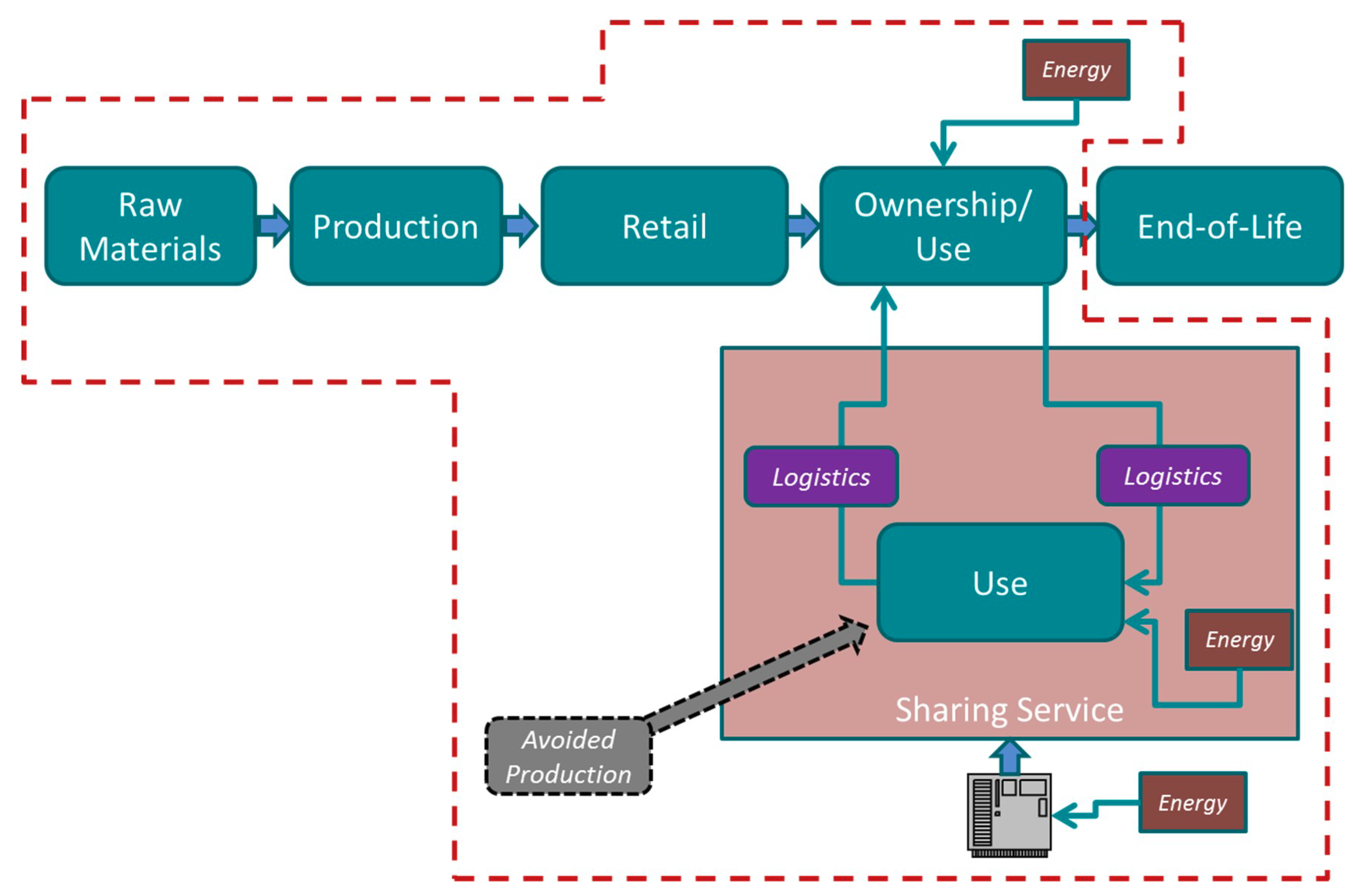
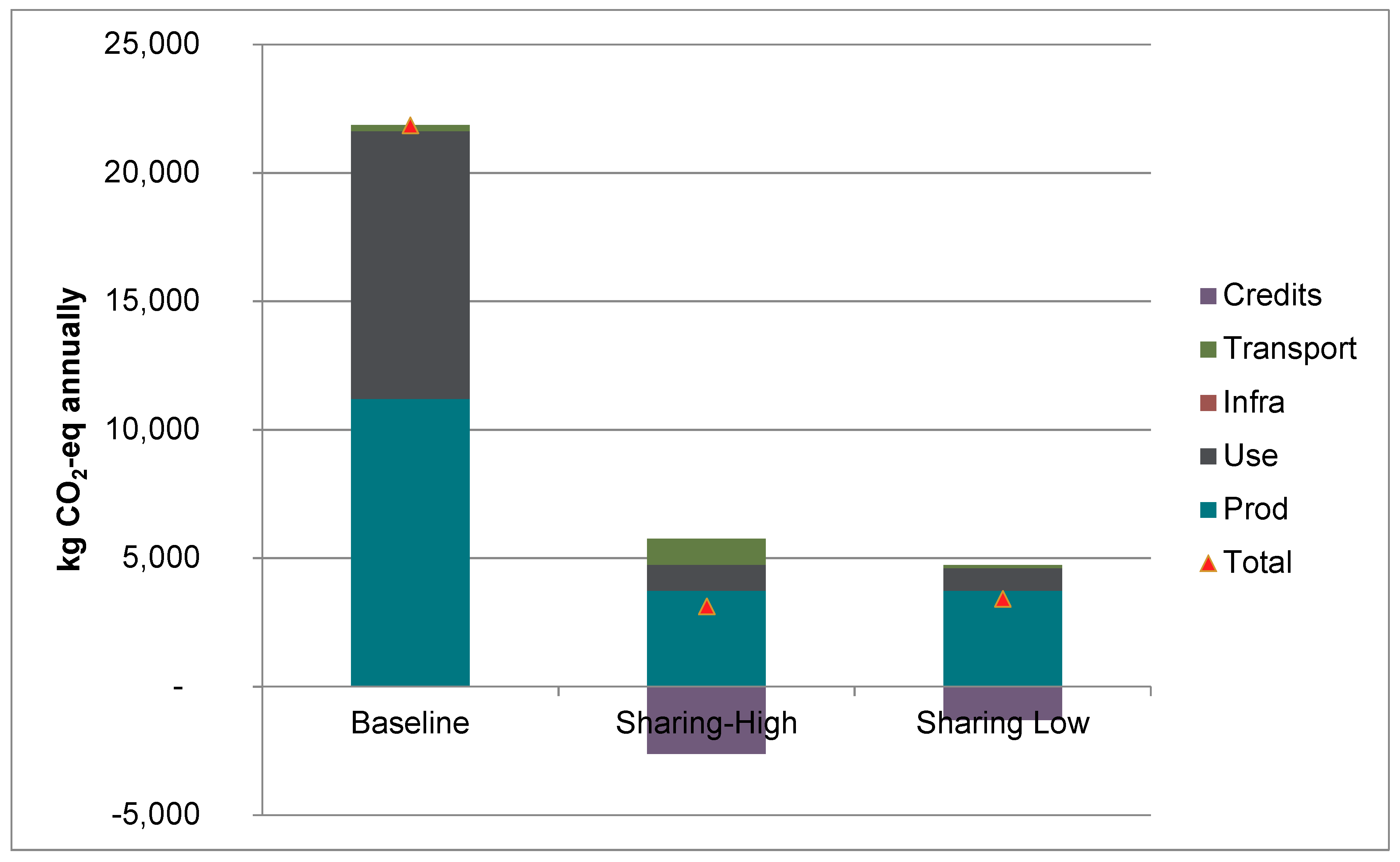
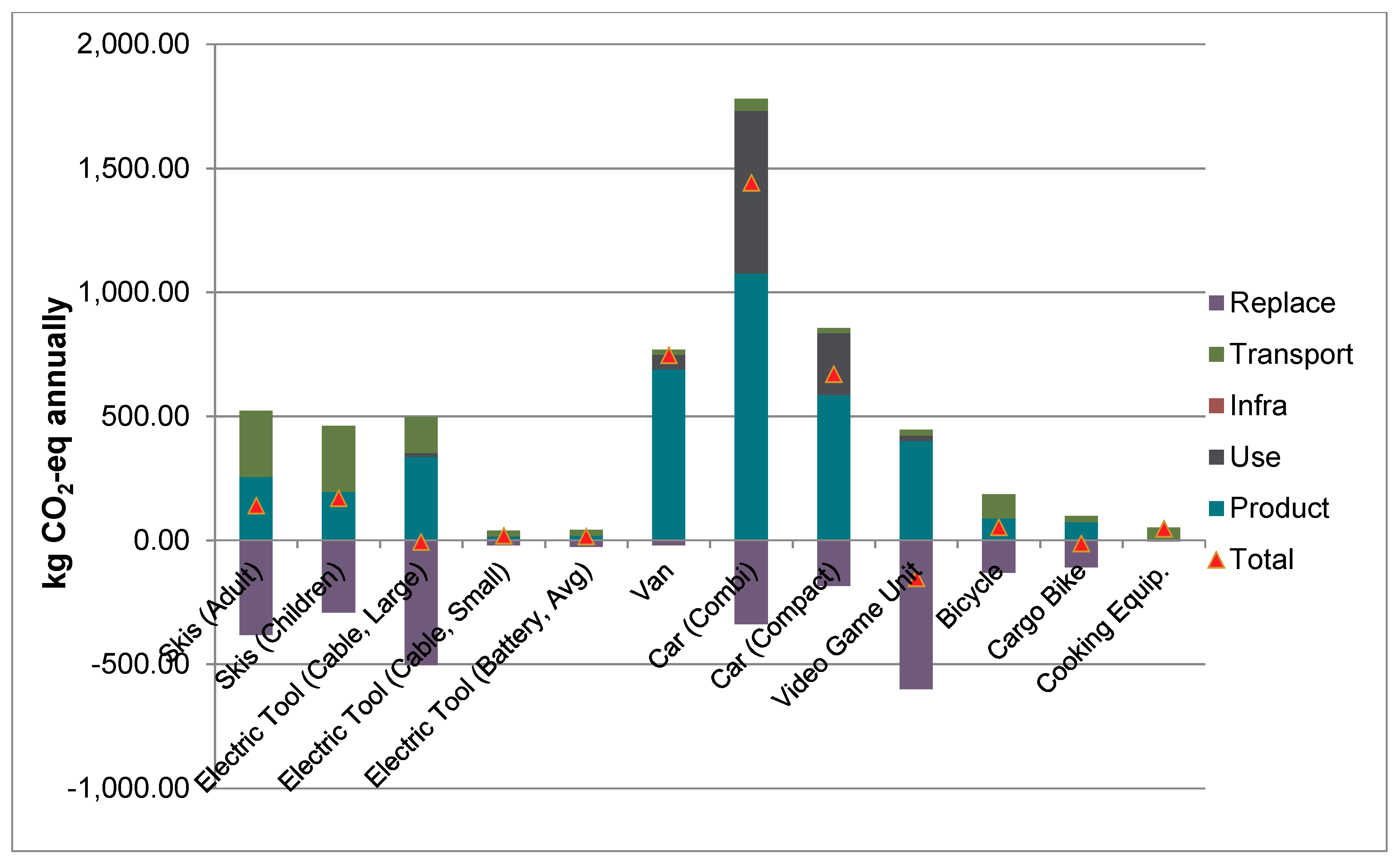
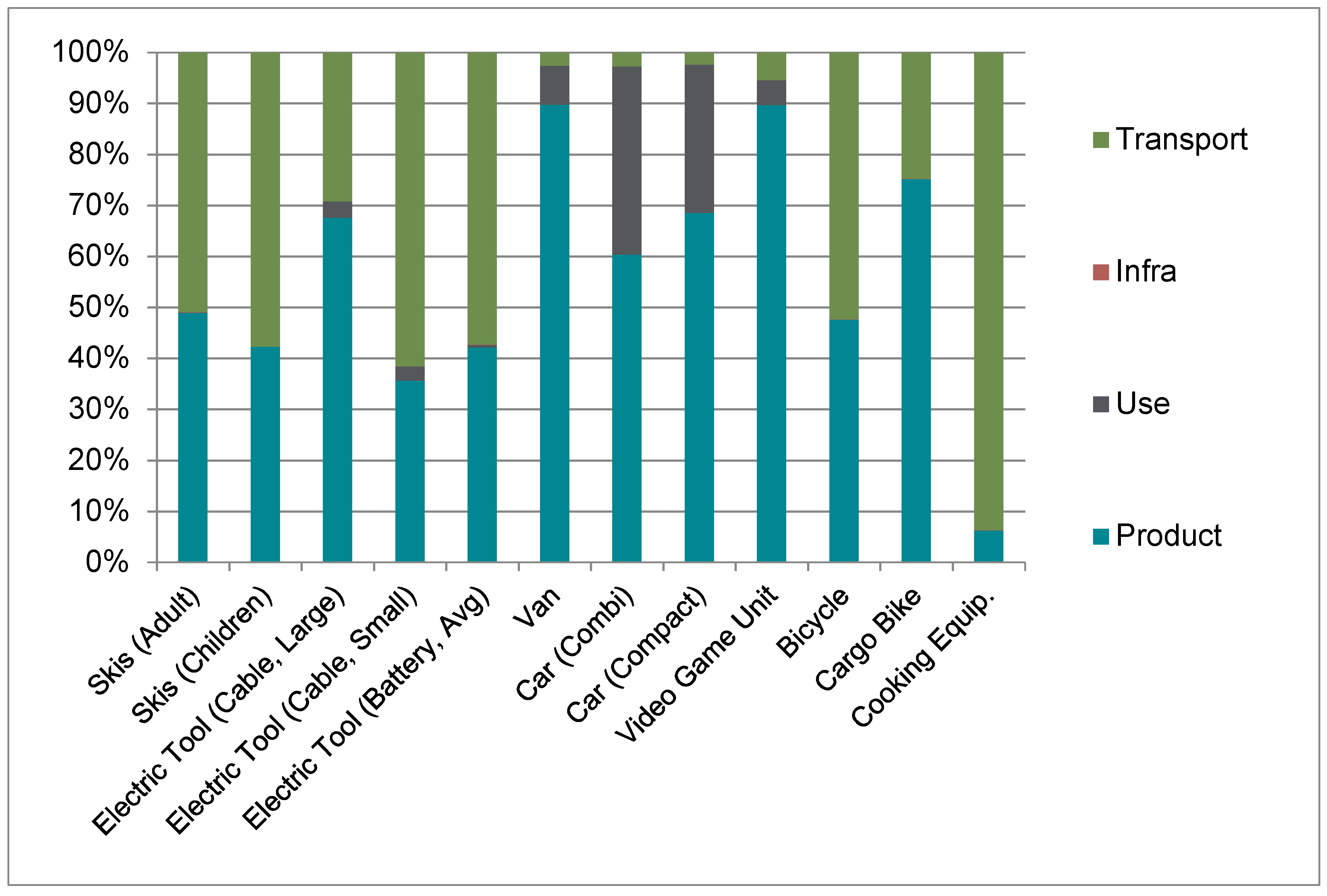
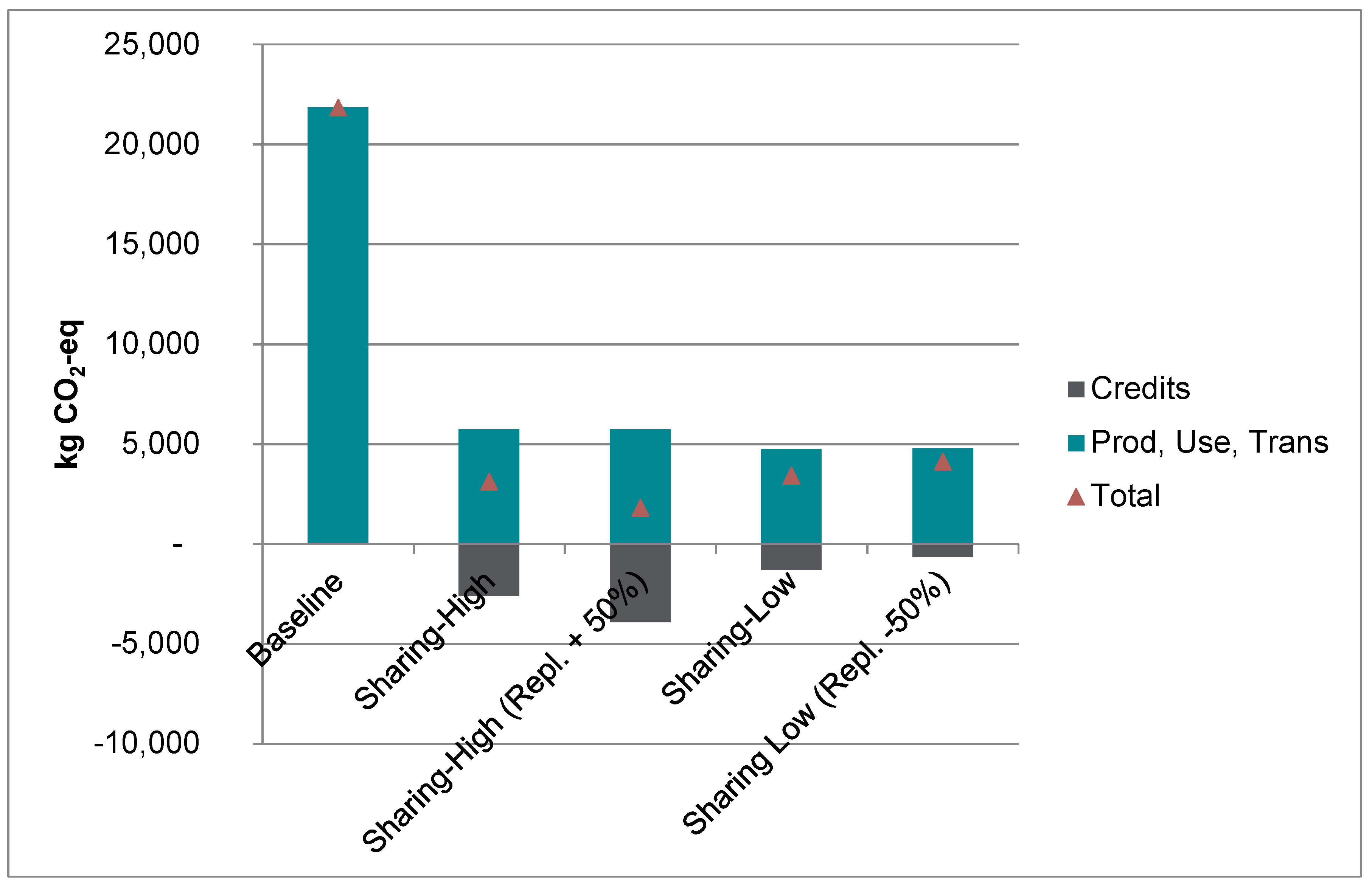
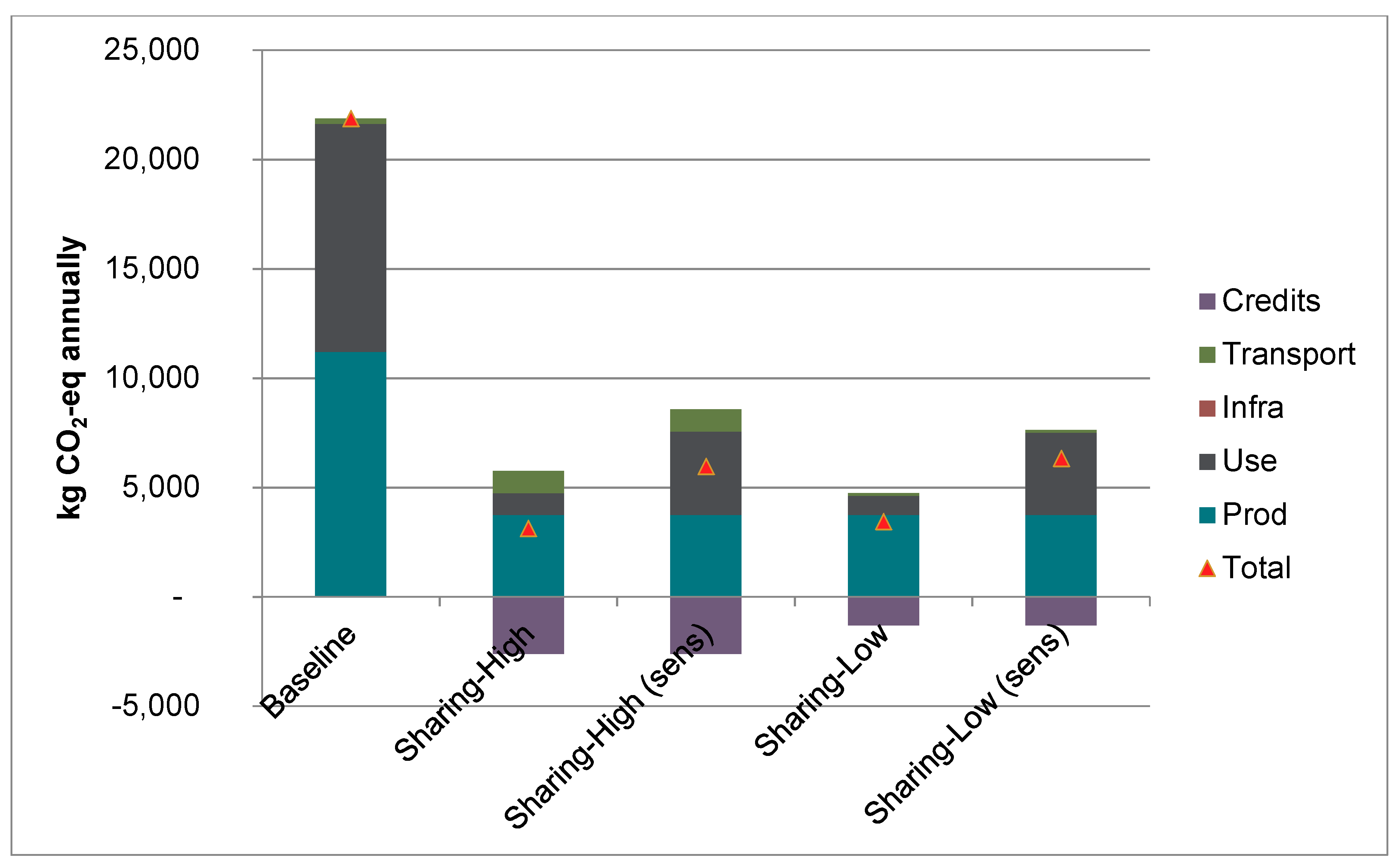
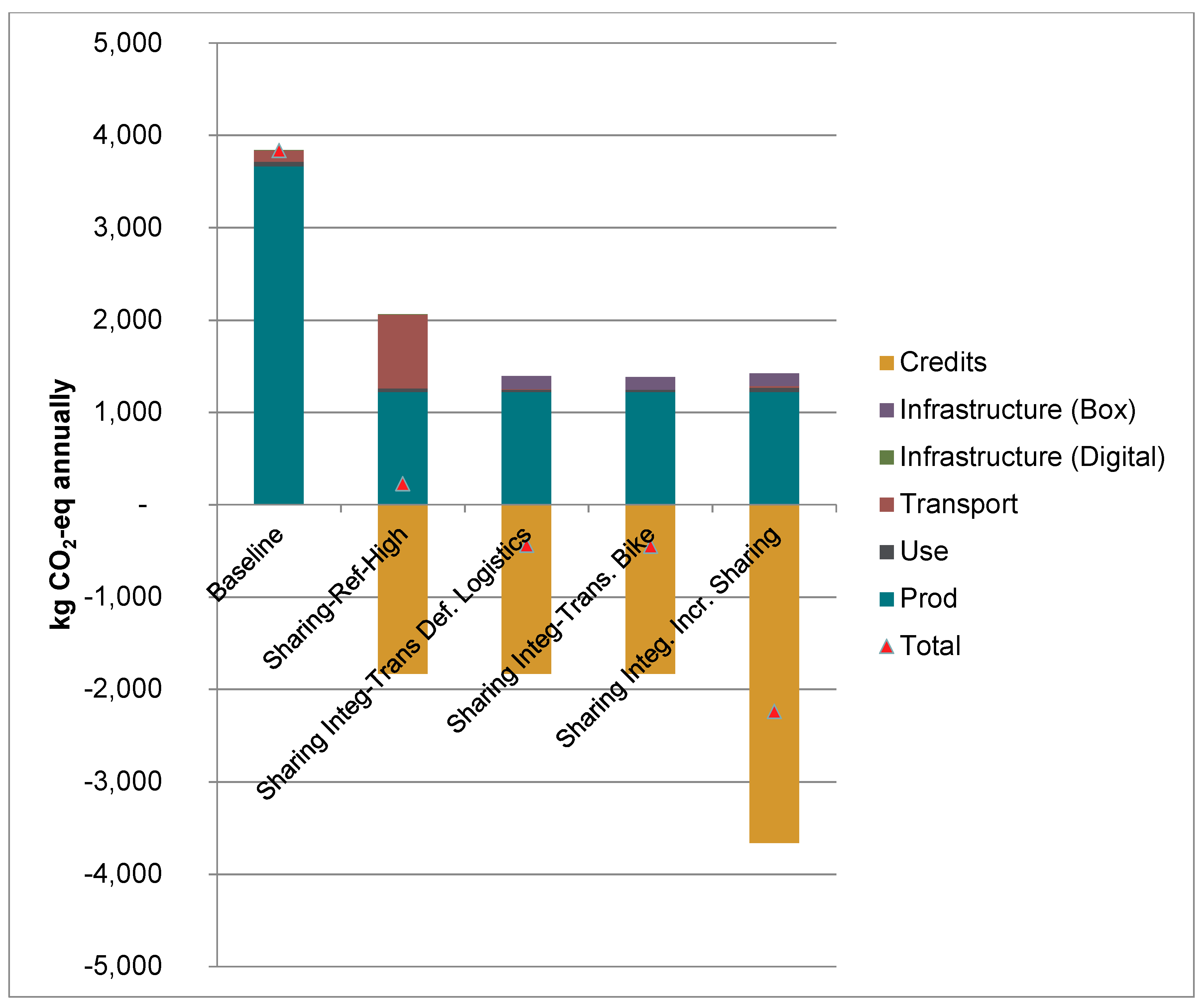
| Products | Number | Unit | Number of Uses |
|---|---|---|---|
| Skis (Adult) | 3 | days | 2 |
| Skis (Children) | 3 | days | 2 |
| Electric Tool (w/o battery), e.g., table saw | 20 | min | 20 |
| Electric Tool (w/o battery), e.g., circle saw, drill | 29 | min | 20 |
| Electric Tool (w/battery), drill | 20 | min | 20 |
| Van | 5 | km | 100 |
| Car (Combi) | 5 | km | 200 |
| Car (Compact) | 5 | km | 200 |
| Video Game Unit | 60 | min | 100 |
| Bicycle | 10 | km | 300 |
| Cargo Bike | 10 | km | 300 |
| Cooking Equipment | 150 |
| Products | Rentals | Number of Listings |
|---|---|---|
| Skis (Adult) | 132 | 44 |
| Skis (Children) | 132 | 44 |
| Electric Tool (w/o battery), e.g., table saw | 72 | 24 |
| Electric Tool (w/o battery), e.g., circle saw, drill | 12 | 4 |
| Electric Tool (w/battery), drill | 12 | 4 |
| Van | 10 | 3 |
| Car (Combi) | 24 | 8 |
| Car (Compact) | 10 | 3 |
| Video Game Unit | 12 | 4 |
| Bicycle | 48 | 16 |
| Cargo Bike | 12 | 4 |
| Cooking Equipment | 24 | 8 |
| Product | High-Impact Transport | Low-Impact Transport | ||||||
|---|---|---|---|---|---|---|---|---|
| Mode | km | Mode | km | Mode | km | Mode | km | |
| Skis (Adult) | Car | 7 | Bus | 3 | Bus | 6 | Bike/walk | 4 |
| Skis (Children) | Car | 7 | Bus | 3 | Bus | 6 | Bike/walk | 4 |
| Electric Tool (w/o battery), e.g., table saw | Car | 7 | Bus | 3 | Bus | 6 | Bike/walk | 4 |
| Electric Tool (w/o battery), e.g., circle saw, drill | Car | 7 | Bus | 3 | Bus | 6 | Bike/walk | 4 |
| Electric Tool (w/battery), drill | Car | 7 | Bus | 3 | Bus | 6 | Bike/walk | 4 |
| Van | Car | 7 | Bus | 3 | Bus | 6 | Bike/walk | 4 |
| Car (Combi) | Car | 7 | Bus | 3 | Bus | 6 | Bike/walk | 4 |
| Car (Compact) | Car | 7 | Bus | 3 | Bus | 6 | Bike/walk | 4 |
| Video Game Unit | Car | 7 | Bus | 3 | Bus | 6 | Bike/walk | 4 |
| Bicycle | Car | 7 | Bus | 3 | Bus | 6 | Bike/walk | 4 |
| Cargo Bike | Car | 7 | Bus | 3 | Bus | 6 | Bike/walk | 4 |
| Cooking Equipment | Car | 7 | Bus | 3 | Bus | 6 | Bike/walk | 4 |
| Replaced Product/Serv | Provider (Uses) | Shared Number of uses (High) | Shared Number of uses (Low) | ||||
|---|---|---|---|---|---|---|---|
| User (Uses) | Per Use | Unit | User (Uses) | Per Use | Unit | ||
| Skis (Adult) | 1 | 5 | - | - | 2 | - | - |
| Skis (Children) | 1 | 5 | - | - | 2 | - | - |
| Electric Tool (w/o battery), e.g., table saw | 8 | 5 | 20 | min | 20 | 20 | min |
| Electric Tool (w/o battery), e.g., circle saw, drill | 8 | 5 | 20 | min | 20 | 20 | min |
| Electric Tool (w/battery), drill | 8 | 5 | 20 | min | 20 | 20 | min |
| Van | 20 | 5 | 5 | km | 100 | 5 | km |
| Car (Combi) | 40 | 5 | 5 | km | 200 | 5 | km |
| Car (Compact) | 40 | 5 | 5 | km | 200 | 5 | km |
| Video Game Unit | 40 | 5 | 60 | min | 100 | 60 | min |
| Bicycle | 120 | 5 | 20 | km | 300 | 20 | km |
| Cargo Bike | 120 | 5 | 20 | km | 300 | 20 | km |
| Cooking Equipment | 60 | 5 | - | - | 150 | - | - |
| Replaced Product | Lifetime (Years) |
|---|---|
| Skis (Adult) | 5 |
| Skis (Children) | 5 |
| Electric Tool (w/o battery), e.g., table saw | 5 |
| Electric Tool (w/o battery), e.g., circle saw, drill | 5 |
| Electric Tool (w/battery), drill | 5 |
| Van | 15 |
| Car (Combi) | 15 |
| Car (Compact) | 15 |
| Video Game Unit | 5 |
| Bicycle | 15 |
| Cargo Bike | 15 |
| Cooking Equipment | 4 |
| Replaced Product | High | Low | ||
|---|---|---|---|---|
| Replace (%) | Replaced Prods. | Replace (%) | Replaced Prods. | |
| Skis (Adult) | 50% | 66 | 25% | 33 |
| Skis (Children) | 50% | 66 | 25% | 33 |
| Electric Tool (w/o battery), e.g., table saw | 50% | 36 | 25% | 18 |
| Electric Tool (w/o battery), e.g., circle saw, drill | 50% | 6 | 25% | 3 |
| Electric Tool (w/battery), drill | 50% | 6 | 25% | 3 |
| Van | 1% | 1 | 1% | 1 |
| Car (Combi) | 11% | 3 | 5% | 1 |
| Car (Compact) | 11% | 1 | 5% | 1 |
| Video Game Unit | 50% | 6 | 25% | 3 |
| Bicycle | 50% | 24 | 25% | 12 |
| Cargo Bike | 50% | 6 | 25% | 3 |
| Cooking Equipment | 50% | 12 | 25% | 6 |
| Phase | Baseline | Sharing-High | Sharing-High (Life) | Sharing-Low | Sharing-Low (Life) |
|---|---|---|---|---|---|
| Production | 11,200 | 3730 | 5330 | 3730 | 3880 |
| Use | 10,430 | 1000 | 1000 | 880 | 1000 |
| Transport | 240 | 1010 | 1010 | 120 | 120 |
| Credits | −2620 | −3740 | −1310 | −2010 | |
| Total | 21,870 | 3120 | 3600 | 3420 | 2990 |
| Phase | Baseline | Sharing-High | Sharing-High (Trans.) | Sharing-Low | Sharing-Low (Trans.) |
|---|---|---|---|---|---|
| Production | 11,200 | 3730 | 3730 | 3730 | 3730 |
| Use | 10,430 | 1000 | 1000 | 880 | 880 |
| Transport | 240 | 1010 | 5040 | 120 | 290 |
| Credits | −2620 | −2620 | −1310 | −1310 | |
| Total | 21,870 | 3120 | 7150 | 3420 | 3590 |
© 2019 by the authors. Licensee MDPI, Basel, Switzerland. This article is an open access article distributed under the terms and conditions of the Creative Commons Attribution (CC BY) license (http://creativecommons.org/licenses/by/4.0/).
Share and Cite
Martin, M.; Lazarevic, D.; Gullström, C. Assessing the Environmental Potential of Collaborative Consumption: Peer-to-Peer Product Sharing in Hammarby Sjöstad, Sweden. Sustainability 2019, 11, 190. https://doi.org/10.3390/su11010190
Martin M, Lazarevic D, Gullström C. Assessing the Environmental Potential of Collaborative Consumption: Peer-to-Peer Product Sharing in Hammarby Sjöstad, Sweden. Sustainability. 2019; 11(1):190. https://doi.org/10.3390/su11010190
Chicago/Turabian StyleMartin, Michael, David Lazarevic, and Charlie Gullström. 2019. "Assessing the Environmental Potential of Collaborative Consumption: Peer-to-Peer Product Sharing in Hammarby Sjöstad, Sweden" Sustainability 11, no. 1: 190. https://doi.org/10.3390/su11010190
APA StyleMartin, M., Lazarevic, D., & Gullström, C. (2019). Assessing the Environmental Potential of Collaborative Consumption: Peer-to-Peer Product Sharing in Hammarby Sjöstad, Sweden. Sustainability, 11(1), 190. https://doi.org/10.3390/su11010190






